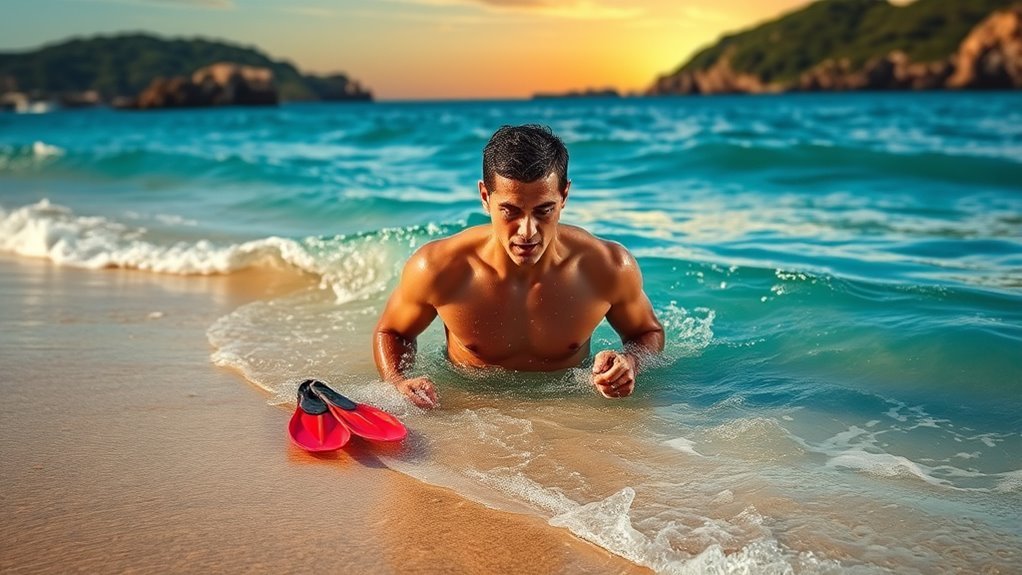To condition your body for ocean swimming, you need to build endurance, strength, and skill. Start by gradually increasing your swim distances and incorporating strength training to target key muscle groups. Focus on enhancing your swimming technique and adapting to cold water temperatures. Don't forget hydration and nutrition; they're essential for energy and recovery. Also, be mindful of ocean safety measures. Stay tuned for more tips on optimizing your training for successful ocean swims!
Understanding the Unique Challenges of Ocean Swimming
While you may love swimming in a pool, ocean swimming presents unique challenges that require specific preparation. The unpredictability of waves and currents can make every swim feel like an adventure, but it's vital to respect their power. Unlike a calm pool, the ocean can change in an instant, so you've gotta stay alert and adaptable.
You'll also face temperature fluctuations, which can be invigorating or chilling, depending on the conditions. Knowing how to manage these temperature changes will keep you comfortable and safe. Additionally, the ocean's vastness can lead to disorientation, so honing your navigation skills is significant.
Wildlife encounters, from schools of fish to curious seals, can enhance your experience, but always be aware of your surroundings. Embracing these challenges means you're not just swimming; you're connecting with nature in a thrilling way that fosters a sense of freedom and adventure.
Building Endurance Through Long-Distance Training
To successfully tackle ocean swimming, you need to build endurance through long-distance training, as this prepares your body for the extended time spent in the water. Embracing the vastness of the ocean means you'll want to be out there for hours, enjoying the freedom it brings. Here are three ways to enhance your endurance:
Building endurance for ocean swimming is essential; prepare to enjoy hours in the water with focused training.
- Gradual Distance Increases: Start with shorter swims and gradually increase your distance each week. This helps your body adapt without overwhelming it.
- Consistent Training Schedule: Aim for regular swim sessions, ideally three to four times a week. Consistency is key to building stamina.
- Mix It Up: Incorporate different strokes and conditions; swimming in varying environments mimics ocean challenges and keeps training exciting. Additionally, cross-training activities like cycling or yoga can enhance overall stamina and reduce injury risk.
Strengthening Key Muscle Groups for Ocean Swimming
As you prepare for ocean swimming, strengthening key muscle groups is essential for both performance and injury prevention. Focus on your core, shoulders, and legs. A strong core stabilizes your body, allowing for efficient movement through the water. Incorporate planks, Russian twists, and leg raises to build this foundation.
Next, target your shoulders and upper back to enhance your stroke. Exercises like pull-ups, resistance band pulls, and shoulder presses will help you develop the strength needed for powerful strokes.
Finally, don't forget your legs! Strong legs propel you forward and help maintain balance. Squats, lunges, and calf raises are great for building strength and endurance. Additionally, integrating squats and lunges into your routine can improve your overall balance and coordination, crucial for effective swimming.
Enhancing Your Technique for Open Water
Improving your technique for open water swimming is crucial, especially since the dynamic environment can present unique challenges. The freedom of the ocean is invigorating, but mastering your technique can elevate your experience. Here are three key aspects to focus on:
Mastering open water swimming technique enhances your experience, allowing you to navigate challenges with confidence and ease.
- Body Position: Keep your body streamlined. A flat, horizontal position minimizes drag and helps you glide effortlessly through the water.
- Breathing Rhythm: Develop a consistent breathing pattern. Practice bilateral breathing to maintain balance and confidence as you navigate waves.
- Sightings: Regularly lift your head to sight landmarks. This guarantees you stay on course and helps you adapt to changing currents without losing momentum.
Adapting to Cold Water Temperatures
While the thrill of ocean swimming can be exhilarating, adapting to cold water temperatures is essential for both comfort and performance. To prepare your body, gradual exposure is key. Start with shorter swims in cooler water and progressively increase your time. This helps your body acclimate and enhances your tolerance.
Here's a simple guide to help you adapt:
| Duration of Exposure | Water Temperature |
|---|---|
| 10-15 minutes | 60°F (15°C) |
| 20-30 minutes | 55°F (13°C) |
| 30+ minutes | 50°F (10°C) |
Learning to Navigate Ocean Currents
Steering through ocean currents can feel intimidating, especially for beginners, but with some practice, you can master this essential skill. Understanding ocean currents is key to enjoying the freedom of open water swimming. Here are three tips to help you navigate:
- Observe the Patterns: Before you enter the water, watch the water's surface to identify the direction and strength of the currents. Look for ripples, foam, or changes in water color.
- Swim Diagonally: When currents pull you sideways, swim at an angle to counteract the drift. This technique helps you maintain your intended path and keeps you moving toward your destination.
- Stay Relaxed: Tension can slow you down. Keep your body relaxed and your strokes smooth to work with the current rather than against it.
Practicing Breath Control in Saltwater
Once you're comfortable steering through ocean currents, the next skill to focus on is breath control in saltwater. Learning to manage your breath will not only enhance your swimming experience but also grant you a sense of freedom in the ocean's embrace. Start by practicing inhaling deeply through your mouth while your face is submerged. This helps you adapt to the saltwater while keeping calm.
As you swim, aim to exhale slowly through your nose, releasing bubbles gently. This rhythm will keep you relaxed and guarantee you're not gulping in water. Try incorporating breath-holding exercises while floating; it builds your lung capacity and boosts your confidence.
When you're ready, practice timed breaths during your strokes—inhale every three to five strokes, giving your body the oxygen it craves while maintaining a steady pace. Embrace this practice, and soon you'll feel invincible in the vast ocean.
Incorporating Safety Measures for Ocean Swimmers
As you venture into the ocean, it's important to prioritize safety to guarantee an enjoyable experience. The vastness of the sea can be both exhilarating and intimidating, so taking precautions is key to your freedom in the water. Here are three significant safety measures to keep in mind:
- Buddy Up: Always swim with a partner. Having someone with you can be crucial in case of emergencies.
- Check Conditions: Before diving in, assess the ocean's conditions. Look out for rip currents, wave height, and weather changes to stay aware and avoid danger.
- Wear a Floatation Device: Consider using a buoy or swim vest. These can offer extra support, especially in unpredictable waters.
The Importance of Hydration and Nutrition
While you may be focused on building your swimming endurance, don't overlook the essential role that hydration and nutrition play in your performance. Staying hydrated keeps your muscles functioning efficiently and boosts your energy levels, letting you glide through the waves with ease. Think of water as your swimming companion, essential for feeling free and unencumbered. Proper hydration supports optimal performance and helps you avoid fatigue that can sideline your efforts in the water.
Nutrition is just as critical. Fueling your body with the right mix of carbohydrates, proteins, and healthy fats prepares you for those long ocean swims. Incorporate whole foods like fruits, veggies, and lean proteins into your meals to energize your body naturally.
Don't ignore snacks! A quick bite before hitting the water can elevate your stamina. Listen to your body—it knows what it needs. When you prioritize hydration and nutrition, you're not just training; you're setting yourself free to enjoy every moment in the ocean.
Creating a Structured Training Plan for Ocean Swimming
To make the most of your ocean swimming experience, creating a structured training plan is crucial. It'll not only boost your confidence but also enhance your overall performance in the water. Here's how to get started:
- Set Clear Goals: Define what you want to achieve—whether it's building endurance, improving speed, or mastering open-water navigation.
- Create a Weekly Schedule: Dedicate specific days to different workouts, mixing swimming with strength training and flexibility exercises. Make sure you include rest days for recovery.
- Track Your Progress: Keep a journal or use an app to monitor your swims, noting distances, times, and how you felt. This'll help you adjust your plan as needed.
With this structured approach, you'll embrace the freedom of the ocean like never before, feeling empowered and ready to tackle those waves!
Frequently Asked Questions
What Should I Wear for Ocean Swimming?
Imagine diving into waves, feeling the freedom of the ocean. You'll want a comfy swimsuit, maybe a rash guard for sun protection, and don't forget a good pair of water shoes for safety and grip.
How Do I Protect My Skin From Sun Exposure?
To protect your skin from sun exposure, wear a broad-spectrum sunscreen with at least SPF 30, reapply regularly, and consider protective clothing. Don't forget a hat and sunglasses—your skin deserves that extra care!
Are There Specific Ocean Swimming Etiquette Rules?
When swimming in the ocean, you should respect other swimmers' space, avoid splashing, and signal your intentions. Always keep an eye on local wildlife and follow posted guidelines to guarantee a safe, enjoyable experience for everyone.
How Do I Deal With Sea Creatures While Swimming?
When swimming, keep calm if you encounter sea creatures. Respect their space, avoid sudden movements, and observe from a distance. You're in their world, so embrace the adventure and enjoy the ocean's beauty.
What Are the Signs of Ocean Swimming Fatigue?
Ever felt that tug of exhaustion pulling you under? Signs of ocean swimming fatigue include heavy limbs, shortness of breath, and decreased coordination. Listen to your body; it's your guide to freedom in the waves.




